3rd Stage Report
2014. Stage III. Synthesis and structural analysis of macrocycles and podant derivatives
In this stage there was brought contributions to objectives O3-O7.
A.III.1. Synthesis of the necessary intermediary
There was accomplished as we described in stage I, A.I.1.
A.III.2. Synthesis of a new nitrogen podant type P4 having in the same molecule a π–
deficient 6-membered ring nitrogen heterocycle and a π–reach 5-membered ring nitrogen
heterocycle, connected via different spacers.
In this stage, the synthesis of a new class of nitrogen podants type P4 have been performed. The podants type P4 have in the same molecule two π–reach nitrogen heterocycles of imidazole type and two π–deficient nitrogen heterocycles of pyridine type. The two type of nitrogen heterocycles have been connected via a methylene spacer, while the two π–deficient nitrogen heterocycles of pyridine type were connected via a dihydroxyacetophenone unit. The synthesis of the new class of nitrogen podants type P4 have been performed using a straightforward and efficient way of synthesis, which involve 2 steps:
- the first step is a bis-etherification of dihydroxyacetophenone (I) with pyridine derivatives having an activated halogen atom, which are leading to dihydroxyacetophenone derivatives having in molecule two units of pyridine with activated halogen atoms (II);
- in the second step the dihydroxyacetophenone derivatives having in molecule two units of pyridine with activated halogen atoms (II) was used for the quaternization of imidazole derivatives via a N-alkylation reaction, leading to the corresponding nitrogen podants type P4:
The reactions were performed under conventional TH, US and MW irradiation. Comparative studies TH versus US and MW irradiations have been performed and, hypotheses concerning the efficiency of these setup procedures have been formulated.
In the next step, P4 was tested as chemosensor (complexation with metals, Mm+) and also was tested their ability to function as compounds with antimicrobial and anticancer activity (see also A.III.4). In this respect thecomplexation ability of P4 was tested using bivalent metals (copper and zinc) and than was tested their ability to function as logic gate via fotoinducted electron transfer (PET). Our results proved that our P4 podant function as a NOR logic gate with two inputs [H+ and Mm+] and one output (fluorescence), being a fluorophore-spacer-receptor-spacer-fluorophore system. Bellow are presented the logic scheme and true table.
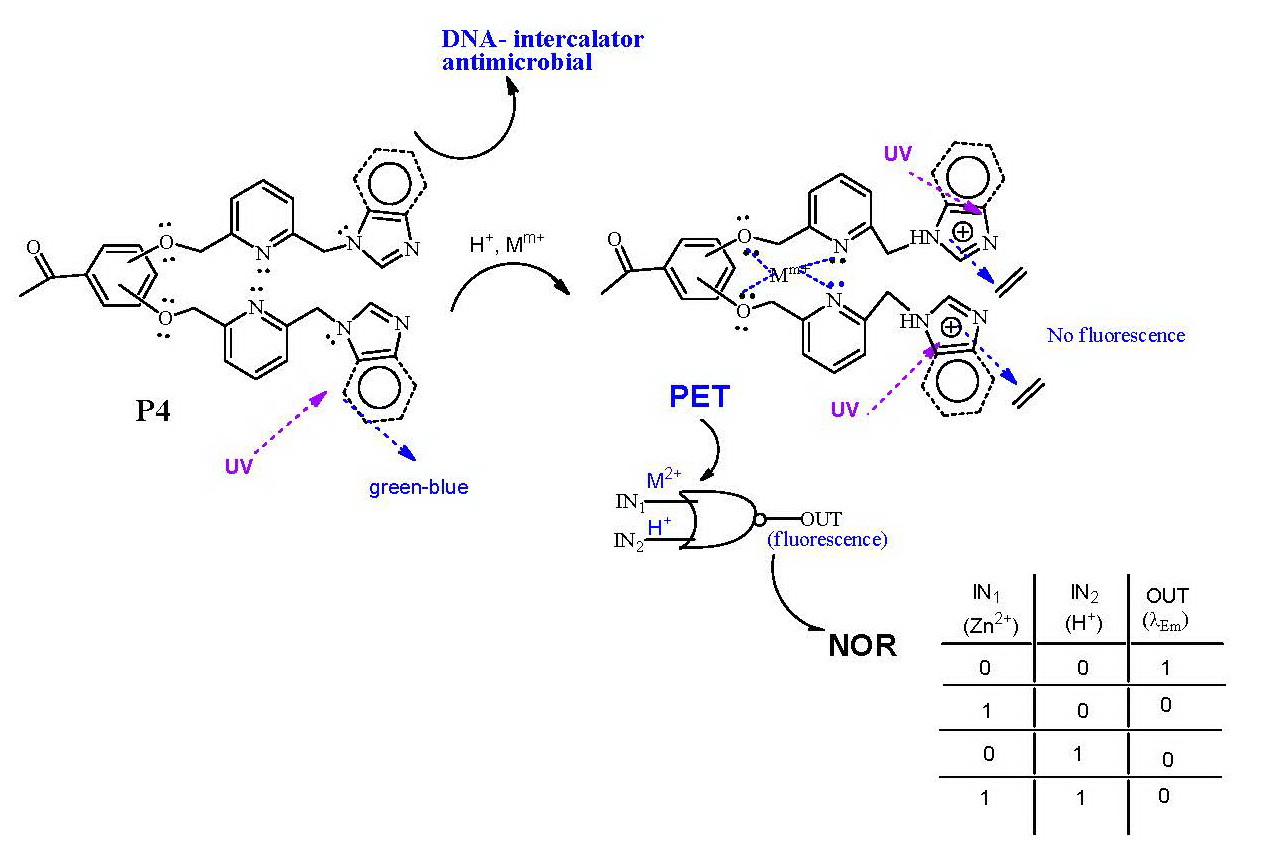
A.III.3. Synthesis of new nitrogen podant type P8 having in the same molecule a p–deficient 6-membered ring azaheterocycle connected via different spacers with a bis-alkylator unit.
In this stage, the synthesis of a new class of nitrogen podants type P8 has been performed. The podants type P8 have in the same molecule two p–deficient nitrogen heterocycles of pyridine type and two bis-alkylating units. The pyridine heterocycles have been connected with the bis-alkylating units via a methylene spacer, while the pyridine heterocyles were connected via a dihydroxyacetophenone unit. As in the previously cases, the synthesis of the new class of nitrogen podants type P8 have been performed using a straightforward and efficient way of synthesis, which involve 3 steps:
- the first step is a bis-etherification of dihydroxyacetophenone (I) with pyridine derivatives having an activated halogen atom, which are leading to dihydroxyacetophenone derivatives having in molecule two units of pyridine with activated halogen atoms (II);
- in the second step the dihydroxyacetophenone derivatives having in molecule two units of pyridine with activated halogen atoms (II) was used for the alkylation of diethanolamine derivatives via a N-alkylation reaction, leading to the corresponding nitrogen podants type P8’;
- in the last step, a chlorination reaction with thionyl chloride of the type P8’ podants, is leading to a new class of nitrogen podants type P8 which have in the same molecule two p–deficient nitrogen heterocycles of pyridine type and two bis-alkylating units:
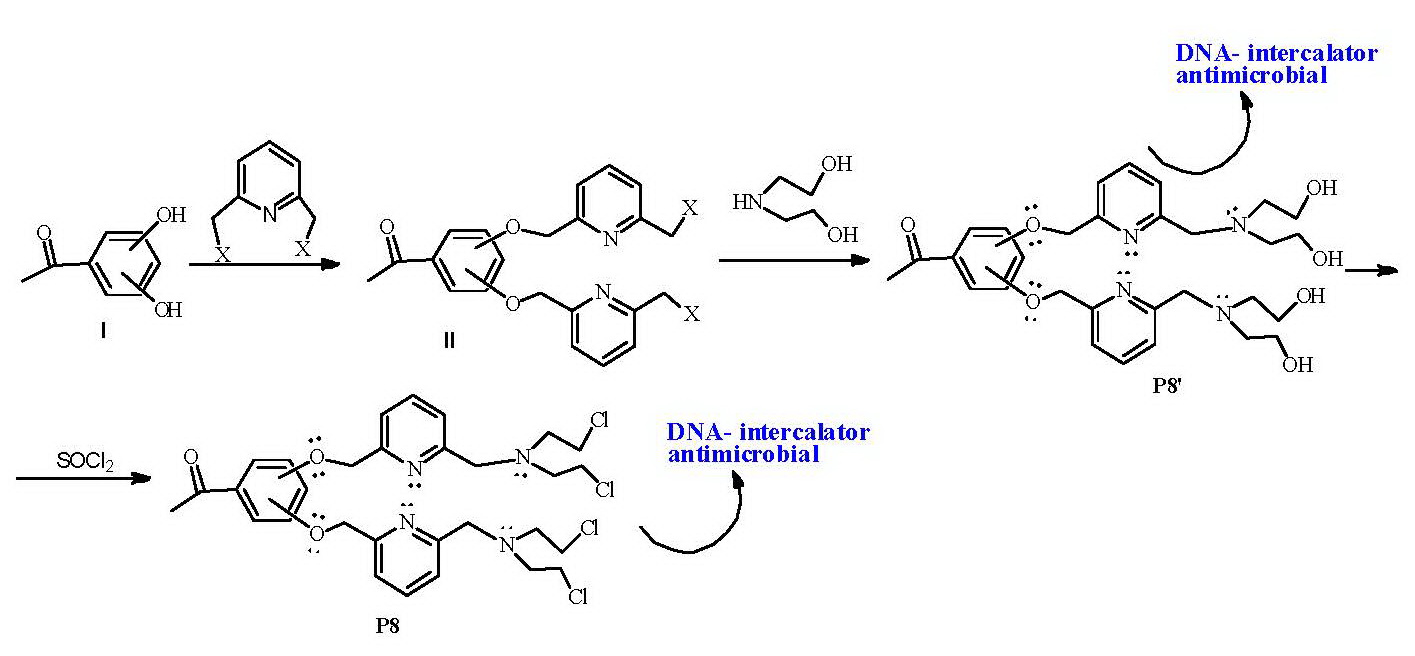
The reactions were performed under conventional TH, US and MW irradiation. Comparative studies TH versus US and MW irradiations have been performed and, hypotheses concerning the efficiency of these setup procedures have been formulated.
In the next step, P8 and P8’was tested as chemosensors (complexation with metals, Mm+) and presently their anticancer and antibicrobial activity is tested. Thus, thecomplexation ability of P8 using bivalent metals (copper and zinc) was tested, and the corresponding complexes were obtained. The most probable the complexation took place to the nitrogen atoms, but until now we did not obtain monocrystals which could prove unambiguously the structure.

A.III.4. Evaluation of the biological active properties
Some of the newly obtained compounds was tested as potential antimicrobials and antitumoral drugs.
The antifungal activity of the synthesized podants type P2, P2’, P4 and P8 and also of some intermediars (as model molecules) were evaluated.
The tests were performed on 4 type of fungus strains: Candida albicans ATCC 10231, Candida glabrata ATCC MYA 2950, Candida parapsilosis ATCC 22019 and Candida sake . Antifungal activities of the compounds were determined by the disc diffusion method. The microbial suspension (0.5 McFarland turbidity standard) was mixed (1/10 ratio) with agar nutrient Sabouraud. Chloramphenicol and Nysatin were purchased from the market (Himedia, Mumbai, India) and used as control drugs for antifungal activities. The tests show us that the tested compounds have a week to moderate antifungal activity
The antitubercular activity of the synthesized podants type P2, P2’, P4 and P8 and also of some intermediars (as model molecules) were evaluated. Compounds were evaluated for antimycobacterial activity against Mycobacterium tuberculosis, as a part of the TAACF TB screening program under direction of the US National Institute of Health, the NIAID division. Antimycobacterial activities of the compounds were performed by Center of Tuberculosis Antimicrobial Acquisition and Coordinating Facility (TAACF) at Southern Research Institute.
The antitubercular tests indicate that some compounds are potent inhibitors against M. tuberculosis, two type of podants from the class P2 and P2’ being selected for Cycle-2 screening assay. Thus, these compounds have a remarkable activity against both replicating and non-replicating M. tuberculosis, both in aerobic conditions [MIC (mM) around 100, IC50 (mM) between 40 and 90, IC90 (mM) between 100 and 140] and anaerobic conditions [MIC (mM) around 150, IC50 (mM) around 25, IC90 (mM) around 60 si 90]. Moreover, one compound from P2 class have an bactericidal mechanism of action and un excellent activity against intracellular Mycobacterium tuberculosis (IC50 (mM, log kill) 2.4 to a concentration of 200). Even more, one compound from P2’ class have proved to be active against resistant strains of Mycobacterium tuberculosis [MIC (mM) >50, pt INH-1, INH-R2, RIF-R1, RIF-R2, FQ-R1]
Some other details concerning antimycobacterial activities of some other phenanthroline derivatives, appear in a paper published in Lett. Drug. Des. Discov., 12, 14-19, 2015, as following:
Microbiology
The Primary Cycle High Throughput Screening (HTS). Determination of 90% inhibitory concentration (IC90), 50% inhibitory concentration (IC50) and Minimum Inhibitory Concentration (MIC)
The MIC of compound was determined by measuring bacterial growth after 5 days in the presence of test compounds [18-21]. Compounds were prepared as 10-point two-fold serial dilutions in DMSO and diluted into 7H9-Tw-OADC medium in 96-well plates with a final DMSO concentration of 2%. The highest concentration of compound was 200 µM where compounds were soluble in DMSO at 10 mM. For compounds with limited solubility, the highest concentration was 50X less than the stock concentration e.g. 100 µM for 5 mM DMSO stock, 20 µM for 1 mM DMSO stock. For potent compounds, assays were repeated at lower starting concentrations. Each plate included assay controls for background (medium/DMSO only, no bacterial cells), zero growth (100 µM Rifampicin) and maximum growth (DMSO only), as well as a rifampicin dose response curve. Plates were inoculated with M. tuberculosis and incubated for 5 days: growth was measured by OD590 and fluorescence (Ex 560/Em 590) using a BioTek™ Synergy 4 plate reader. Growth was calculated separately for OD590 and RFU. To calculate the MIC, the 10-point dose response curve was plotted as % growth and fitted to the Gompertz model using GraphPad Prism 5. The MIC was defined as the minimum concentration at which growth was completely inhibited and was calculated from the inflection point of the fitted curve to the lower asymptote (zero growth) (Fig. 1A). In addition dose response curves were generated using the Levenberg-Marquardt algorithm and the concentrations that resulted in 50% and 90% inhibition of growth were determined (IC50 and IC90 respectively) (Fig. 1B).
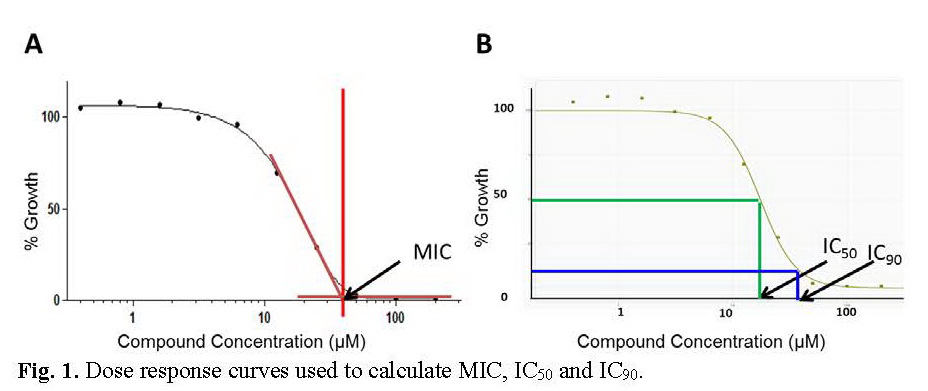
Data points obtained from a dose response growth inhibition assay are curve-fitted using (A) the Gompertz model to calculate MIC and (B) the Levenberg-Marquardt algorithm to calculate IC50 and IC90. (A) The MIC is the concentration at which complete inhibition growth is seen and is derived from the point of inflection at which the curve meets the lower asymptote (zero growth). (B) IC50 and IC90 are points at which growth is inhibited by 50% and 90% respectively. Orange line = MIC; Green line = IC50; Blue line = IC90.
MIC values were reported when the following quality control criteria were satisfied:
- For each plate
- No growth in the background (un-inoculated) control wells
- OD590>0.3 in maximum growth wells
- Rifampicin MIC within 3-fold of the expected value
- For each compound curve. MICs were reported if
- There were 2 points with growth >75%
- There were 2 points with growth <75%
- If only one point was >75% inhibition then the MIC value was reported as the maximum concentration tested
- If no point reached 75% inhibition, the MIC was reported as > maximum concentration tested
RESULTS AND DISCUSSION
In order to reach our goal we initially synthetize the phenanthrolinium monoquaternary salts 1- 8. The reaction pathway adopted for synthesis of phenanthroline derivatives is straightforward and efficient, involving an N-alkylation reaction of 1,7-phenanthroline, Scheme 1.
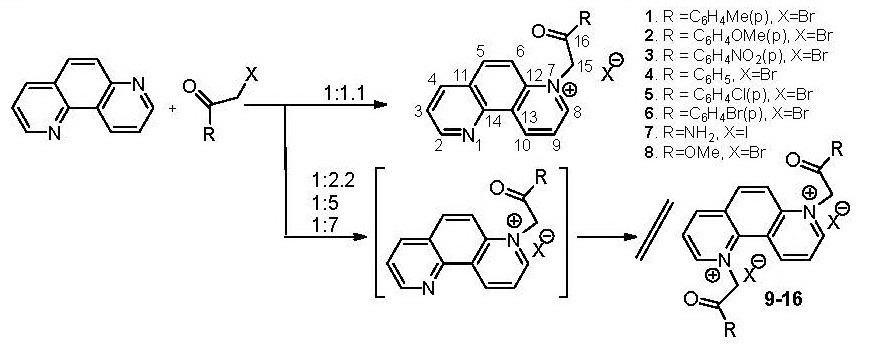
Scheme 1. Reaction pathway to obtain phenanthrolinium salts.
The salts have been prepared in moderate to good yields (50-80%), using a minimum volume of solvent (acetone or acetonitrile), at room temperature or reflux. Our initial target was to obtain both the phenanthrolinium monoquaternary salts (1- 8) and diquaternary salts (9-16). No matter the conditions we employed in terms of molar ratio (1:2.2; 1:5; 1:7) and reaction conditions (solvents, temperature), only phenanthrolinium mono salts, 1- 8, have been obtained. A reasonable explanation for this behaviour could be related to the basicity of N1-nitrogen atom: after the N7-alkylation of 1,7-phenanthroline, in the obtained phenanthrolinium mono salts the basicity of N1-nitrogen decreases so much that a second alkylation could not take place.
The structure of compounds was assigned by elemental and spectroscopic analysis: IR, 1H NMR, 13C NMR, COSY, HMQC and HMBC. Thus, the most important data furnished by 1H NMR spectra are the following: the signals for methylene protons H15 from compounds 1– 6 appear at low field (7.10 – 7.25 ppm, singlet), according with the substituent from the para position of the benzoyl ring. The same protons appear more shielded (5.95 ppm respectively 6.31 ppm) for compounds 7 and 8, due to the weaker withdrawing effect of the adjacent carbonyl amide and ester groups. In the aromatic region, the most unshielded protons are H10 (10.31-10.41 ppm), which are involved in an intramolecular hydrogen bond with atom N1, followed by H8 (9.57-9.69 ppm) situated in the proximity of the positive nitrogen N7. In the 1H NMR spectra of compound 7, the two amide protons (NH2) furnished two singlet signals at 7.87 and 8.19 ppm, respectively, while in the spectrum of compound 8, the methyl ester protons appear as a singlet at 3.81 ppm. In the 13C NMR spectra, the most important data are furnished by the signals corresponding to the C16 (carbonyl) and C15 (methylene)atoms. Thus, for compounds 1–6 possessing C=O ketone groups, the signals for C16 appear at 190.6-188.8 ppm, while for compound 7 having an amide group, respectively for compound 8 with an ester group appear at 165.8 ppm, respectively 166.6 ppm. Methylene C15 atoms give signals at 63.4 -64.1 ppm for compounds 1–6 and at 57.9 -59.3 ppm for compounds 7–8. All the remaining signals from NMR spectra are in accordance with the proposed structures. See also Supporting Information for the 1H and 13C NMR spectra for compounds (5) and (6).
DESIGN AND BIOLOGICAL ACTIVITY
Recently, a successful result on the identification of new antimycobacterial derivatives which contain 1,10-phenanthroline skeleton as pharmacophoric moiety was reported [15]. On the other hand, in case of some diazoles derivatives, it was found that the p–halo-benzoyl moiety is crucial for the antimycobacterial activity [16].
Encouraged by our previous promising results in the field of anti-TB derivatives with nitrogen heterocycle skeleton [11-14] as well as by the good antimicrobial activity of the phenanthrolinium salts 1- 8 [17], we decided to combine the biological potentials of phenanthrolines and p–halo-benzoyl moiety, intending to obtain compounds with better activity and better pharmaceutical properties (i.e., increasing the water solubility, being salts), Scheme 2. In equal measure we were interested to see if changing of the nitrogen position of phenanthroline from 1,10-, to more sterically released 1,7-, will affect somehow the activity.
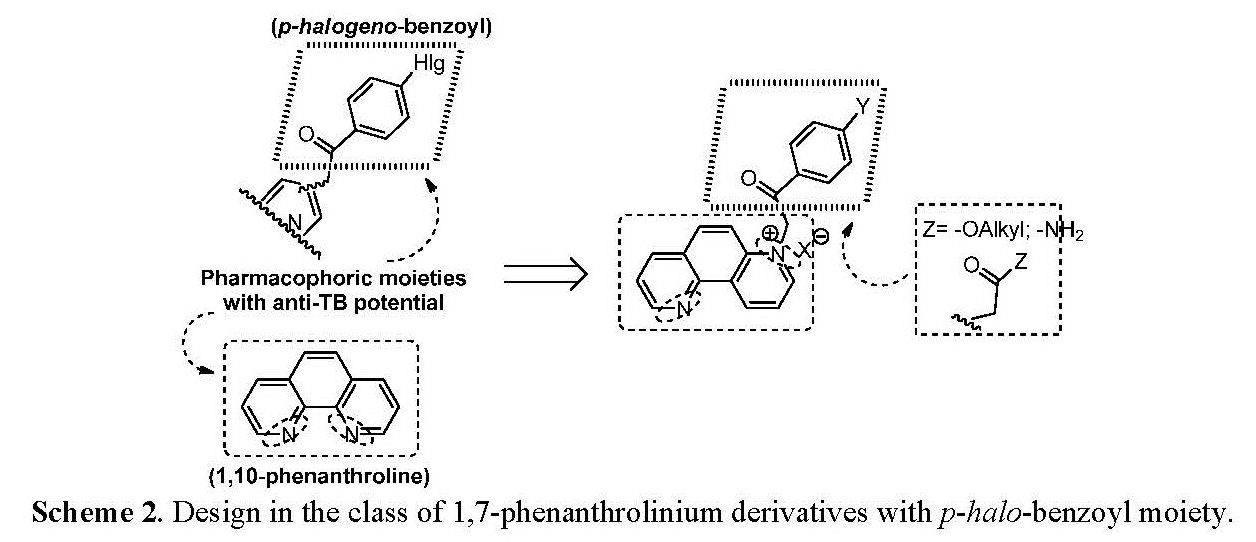
We have had also in view some related salts, 1,7-phenanthrolinium salts with p–substituted-benzoyl / carbalkoxy / acetamide moiety, in order to allow SAR comparisons.
The phenanthrolinium monoquaternary salts 1- 8, were evaluated for in vitro antimycobacterial activity against Mycobacterium tuberculosis H37Rv, grown under aerobic conditions (see Microbiology part). The obtained results are listed in Table 1.
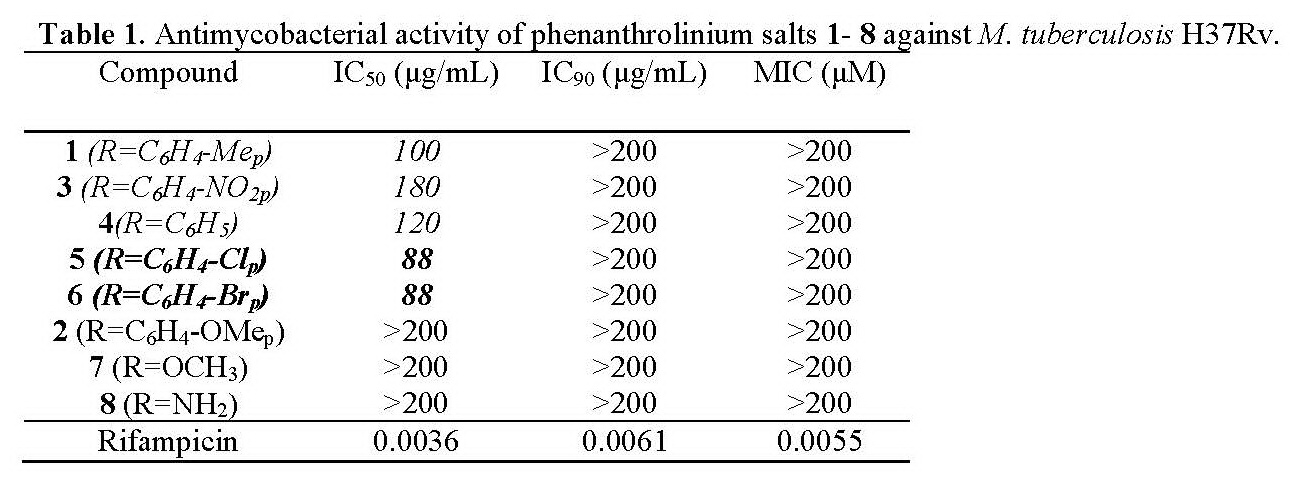
The data from Table 1 illustrate that five from the eight tested compounds had activity against M. tuberculosis H37Rv under aerobic conditions. We may also notice that 1,7-phenanthrolinium salts substituted with p–halo-benzoyl moiety have shown the most pronounced antimycobacterial activity. In the series of 1,7-phenanthrolinium salts, we may notice that salts containing a p–substituted-benzoyl skeleton are more active comparative as those one with carbalkoxy or acetamide moiety.
CONCLUSIONS
In conclusion, the design, synthesis, structure and in vitro antimycobacterial activity of a new class of antimycobacterial of new phenanthroline derivatives with p–halo-benzoyl skeleton is presented. Compounds were prepared by using a straight and efficient method of synthesis. The in vitro antimycobacterial activity of the synthesized compounds was investigated against Mycobacterium tuberculosis H37Rv. Five of the eight tested compounds had activity against M. tuberculosis H37Rv under aerobic conditions, the 1,7-phenanthrolinium derivatives substituted with p–halo-benzoyl moiety having the best activity. A certain influence of the para position of thebenzoyl moiety substituents was observed, the 1,10-phenanthrolinium salts substituted with p–halo (Br, Cl)- benzoyl moiety showing the most pronounced antimycobacterial activity (further studies remain to be done in this respect)
The antitumoral activity of some compounds were evaluated in vitro and screened against human cervix epithelial carcinoma cell line (HeLa), some of the compounds having a promising antitumoral activity. A selection of compounds (P2, P2’ si P4) was selected and tested in vitro for anticancer activity by the National Cancer Institute (NCI, USA), under the Developmental Therapeutics Program (DTP), at a single high dose [10-4 M] cell assay. This assay was performed in a 60 human tumour cell line panel, representing leukemia, melanoma and cancers of lung, colon, brain, breast, ovary, kidney and prostate, in accordance with the protocol of the NCI. Results for each compound were reported as a Mean Graph of the growth percent of the treated cells when compared to the untreated control cells and is available for analysis by the COMPARE program. The results was leading to the following conclusions:
- The azapodants type P4, have a significant anticancer activity against the following tumour cells: Leukemia, Non-Small Cell Lung Cancer, Melanoma, Renal Cancer;
- The azapodants type P2 and P2’, have a significant anticancer activity against the following tumour cells: Renal Cancer, CNS Cancer;
- The phenanthroline derivatives have a significant anticancer activity against the following tumour cells: Renal Cancer, CNS Cancer, Ovarian Cancer, Breast Cancer.
A.III.5. Elemental and structural analysis of the obtained structures. Final stage report
The structure of the newly compounds was proven through elemental and structural analysis: IR, NMR, UV-Vis and fluorescence, MS, X-ray.
A final stage report was accomplished and presented on the web page of the project.
Achievements
- Results Disseminations
- Papers published or accepted for publication: 6
- Danac, R.;Daniloaia, T.; Antoci, V.; Vasilache, V.; Mangalagiu I.I.: Design, synthesis and antimycobacterial activity of some new azaheterocycles: phenanthroline with p-halogeno-benzoyl skeleton. Part V, Lett. Drug. Des. Discov., 12, 14-19, 2015. Bentham Science Publishers, ISSN: 1570-1808. 1875-628X/15 $58.00+.00
- Danac, R.;Mangalagiu I. I.: Antituberculosis activity of nitrogen heterocycles derivatives: bipyridine derivatives. Part III, 74, 664-670, 2014. ELSEVIER FRANCE-EDITIONS SCIENTIFIQUES MEDICALES ELSEVIER, FRANCE , ISSN: 0223-5234. http://dx.doi.org/10.1016/j.ejmech.2013.09.061
- Balan, A.M.; Miron, A.; Tuchilus, C.; Rotinberg, P. Mihai, C.T.; Mangalagiu, I.I.; Zbancioc, Ghe. Syntheses, Antimicrobial and Antitumoral Activity of Some Novel Dihydroxyacetophenone Derivatives, Med. Chem, 10, 476-483, 2014. DOI: 10.2174 / 15734064113096660070 Publisher: Bentham Science Publishers ISSN: 1573-4064 (Print)
- Bejan, V.; Mantu, D.; Cozna, D.G.; Ursu, C.; Mangalagiu, I.I.: Design, synthesis and in vitro cytotoxicities of new tetra- and penta- cyclic azasteroids against human tumor cell lines, Med. Hyp., 82, 11-15, 2014. doi: 10.1016/j.mehy.2013.10.024 PERGAMON-ELSEVIER SCIENCE LTD, ENGLAND. ISSN: 0968-0896
- Zbancioc, Ghe.; Moldoveanu, C.; Zbancioc, A.M.; Mangalagiu, I.I. Microwave Assisted Synthesis of New Pyrrolopyridazine Derivatives with Acetophenone Skeleton. Part V., Curr. Microwave Chem., 1, 41-46, 2014. Publisher: Bentham Science Publishers , I-SSN: 2213-3356 (Print) ISSN: 2213-3364 (Online). DOI: 10.2174/2213335601666140210211520
- Antoci, V.; Mantu, D.; Mangalagiu I. I.: One Pot Synthesis of Cyclophane with Imidazolium Skeleton. An Improved Method , Rev. Chim.-Bucharest, 66(00), 000-000, 2015. Publisher: SYSCOM 18 SRL, CODEN: RCBUAU ISSN: 0034-7752. ROMANIA.
- Papers presented to Scientific Meetings: 11
- Mangalagiu, I.I. Nitrogen heterocycles: an efficient way towards « target compounds » of potential interest and molecular logic devices, 2nd International Conference on Chemical Engineering, 05-08 November, 2014, Iasi, Roumania. P.L., pag. 33 (plenary lecture). www.ch.tuiasi.ro/ICCE2014
- V. Antoci, D. Mantu, M.-O. Apostu, C. Moldoveanu, G. Zbancioc, Mangalagiu, I.I. X-Ray evidence of cyclic and acyclic phthalazinic derivatives with vinyl chain, “Al.I.Cuza“ University Days, October 31-st – November 1-nd, 2014. Iasi, Romania. P40, pag.69. ISSN 2067 – 2438; ISSN (online) 2067 – 2446. http://aci.chem.uaic.ro (Supplement of the Acta Chimica Iasi journal)
- D. Mantu, V. Antoci, C. Moldoveanu, G. Zbancioc, Mangalagiu, I.I. Synthesis and characterization of new anthracene-based imidazolium salts, “Al.I.Cuza“ University Days, October 31-st – November 1-nd, 2014. Iasi, Romania. P41, pag.70. ISSN 2067 – 2438; ISSN (online) 2067 – 2446. http://aci.chem.uaic.ro (Supplement of the Acta Chimica Iasi journal)
- Mangalagiu, I.I. Biological Activity of Some New Azaheterocycles, 3èm Colloque Franco-Roumain de Chimie Médicinale, 30 -31 October, 2014, Iasi, Roumanie. P.L.-12, pag.27 (plenary lecture). www.chem.uaic.ro/~cofrrocm-2014/
- Mangalagiu, I.I. Antimicrobial and anticancer activity of some five- and six-member ring azaheterocycles, COST Action CM1307/CaPF joint meeting “Targeted chemotherapy towards diseases caused by endoparasites”, 27-29 October, 2014, Calvi – Corsica, France. P.L-3, pag.15 (plenary lecture). www.costcm1307.org/CM1307_2/1st_Meeting.html
- Mangalagiu, I.I. Antimicrobial Activity of Some Five and Six Member Ring Azaheterocycles, COST Action CM1307/CaPF joint meeting “Targeted chemotherapy towards diseases caused by endoparasites”, 27-29 October, 2014, Calvi – Corsica, France. Poster, pag.69. www.costcm1307.org/CM1307_2/1st_Meeting.html
- Antoci, V.; Mantu, D.; Nicolescu, A.; Zbancioc, Ghe.; Moldoveanu, C.; Mangalagiu, I.I.: New Imidazolium Salts: NMR Study…, 16-th Central European NMR Symposium, Zabreb, 16 – 17 October 2014. P-1: poster, pag. 10. ISBN 978-953-7941-03-01. http://cecm.irb.hr/ceum2014/book_of_abstracts.pdf
- Mangalagiu, I.I. Azaheterocycles: old stories new outcomes, XXXIII-rd ROMANIAN CHEMISTRY CONFERENCE, 1-3 October 2014, Calimanesti-Caciulata, Romania, C.P.-7, pag.5. (plenary lecture).
- Vasilichia Antoci, Dorina Mantu, Dan Maftei, Alina Nicolescu, Gheorghiţă Zbancioc, Costel Moldoveanu, Mangalagiu, I.I., UV-VIS, FLUORESCENCE AND NMR STUDIES ON ZINC ACETATE COMPLEXATION OF NOVEL ANTHRACENE-IMIDAZOLIUM SALT, XXXIII-rd ROMANIAN CHEMISTRY CONFERENCE, 1-3 October 2014, Calimanesti-Caciulata, Romania, P.S.I.-17, pag.17. (P).
- Mangalagiu, I.I.: New Podants with Nitrogen Heterocycles Skeleton for Multiple Tasks, ”The International Conference dedicated to the 55-th anniversary from the foundation of the ICASM”, Chisinau, 28 – 30 May 2014. L-8: plenary lecture, pag. 13. ISBN 978-9975-62-371-1. http://chem.asm.md/iccsrm
- Zbancioc, Ghe.; Zbancioc, A.M.; Mnagalagiu, I.I. Ultrasound and microwave assisted synthesis of dihydroxyacetophenone derivatives with or without 1,2-diazine skeleton, European Exhibition of Creativity and Invovation, Euroinvent 2014, May 22-24 2014, Iasi, Romania. Class: Inovative Research, pag. 190. Poster, ISBN 978-606-714-037-8. http://eudirect.ro/euroinvent/
- Awards
- May 22-24, 2014. “Gold Medal”, Paper awarded: “Ultrasound and microwave assisted synthesis of dihydroxyacetophenone derivatives with or without 1,2-diazine skeleton”. Euroinvent 2014, Iasi, Romania;
